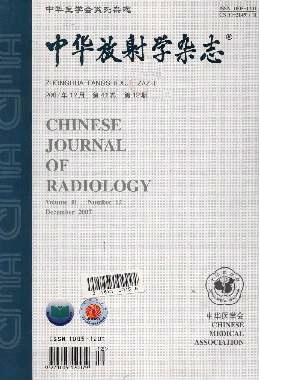Application of 3D-SPACE sequence combined with 3D-TOF MR angiography in follow-up for intracranial aneurysm after stent-assisted coil embolization
Q4 Medicine
Zhonghua fang she xue za zhi Chinese journal of radiology
Pub Date : 2020-03-10
DOI:10.3760/CMA.J.ISSN.1005-1201.2020.03.010
引用次数: 0
Abstract
Objective To explore the application value of three dimensional T1 weighted sampling perfection with application-optimized contrasts by using different flip angle evolutions (3D T1-SPACE) combined with three dimensional time of flight MR angiography (3D-TOF MRA) in the follow-up of stent-assisted coil embolization for intracranial aneurysm. Methods From December 2017 to October 2018, 25 patients with intracranial aneurysm who underwent stent-assisted coil embolization in Henan Provincial People′s Hospital were enrolled. All of them had wide neck intracranial aneurysms and were followed up for 6 to 10 months after endovascular treatment using 3D-TOF MRA, 3D T1-SPACE sequence and DSA. The DSA and 3D-TOF MRA were performed to evaluate aneurysm remnants using Raymond grade scale. Meanwhile, 3D-TOF MRA and 3D T1-SPACE sequence were performed to evaluate in-stent lumen visibility using the 4-point scale. The paired sample Wilcoxon test was used to evaluate the aneurysm remnants and the parent artery patency. DSA was used as the gold standard to calculate the specificity and accuracy of the aneurysm remnants evaluated by 3D-TOF MRA. Results Six to ten months′ follow up after the procedure, for aneurysm occlusion, the Raymond grade scale of the 25 patients evaluated by DSA indicated grade 1 in 23 patients, 2 in 1 and 3 in 1. For patients evaluated by 3D-TOF MRA, the results demonstrated grade 1 in 21 patients, 2 in 3 and 3 in 1. There was no difference between the 2 methods (Z=-0.557, P=0.577). The in-stent lumens of parent vessel evaluated by 3D-TOF MRA showed that there were 14 patients with grade 3, 8 patients with grade 2 and 3 patients with grade 1. However, 3D T1-SPACE demonstrated that all 25 patients were grade 4. The 3D T1-SPACE was superior to evaluate the in-stent lumens than 3D-TOF MRA (Z=-4.484, P<0.001). Taking DSA as standard, the specificity and accuracy of the aneurysm remnants evaluated by 3D-TOF MRA were 86.9% (20/23) and 84.0% (21/25), respectively. Conclusion 3.0 T 3D T1-SPACE MR sequence can be used to assess parent artery patency, with in-stent lumen being clearly visible. 3D-TOF MRA can evaluate intracranial aneurysm remnants. The combination of these two MRI imaging techniques can be used as an optional follow-up evaluation after the endovascular treatment of intracranial aneurysms. Key words: Intracranial aneurysm; Magnetic resonance imaging; Embolization, therapeutic; Follow-up studies3D-SPACE序列联合3D-TOF MR血管造影术在颅内动脉瘤支架辅助线圈栓塞术后随访中的应用
目的探讨不同翻转角度演变(3DT1-SPACE)与三维飞行时间磁共振血管成像(3D-TOF-MRA)在颅内动脉瘤支架辅助线圈栓塞随访中的应用价值。方法选择2017年12月至2018年10月在河南省人民医院接受支架辅助线圈栓塞治疗的颅内动脉瘤患者25例。所有患者均患有宽颈颅内动脉瘤,并在血管内治疗后使用3D-TOF MRA、3DT1-SPACE序列和DSA随访6至10个月。采用Raymond分级量表进行DSA和3D-TOF MRA评估动脉瘤残余。同时,进行3D-TOF MRA和3D T1-SPACE序列,以使用4点量表评估支架内管腔的可见性。配对样本Wilcoxon试验用于评估动脉瘤残余和母动脉通畅性。以DSA作为金标准,计算3D-TOF MRA评价动脉瘤残余的特异性和准确性。结果术后随访6~10个月,25例动脉瘤闭塞患者的Raymond评分分别为1级23例、2级1例和3级1例。对于通过3D-TOF MRA评估的患者,结果显示21名患者为1级,3名患者为2级,1名患者为3级。两种方法之间无差异(Z=-0.557,P=0.577)。3D-TOF MRA评估母血管支架内管腔显示,3级14例,2级8例,1级3例。然而,3D T1-SPACE显示所有25名患者均为4级。以DSA为标准,3D-TOF MRA评价动脉瘤残余的特异性和准确性分别为86.9%(20/23)和84.0%(21/25)。结论3.0T 3D T1-SPACE MR序列可用于评估母动脉的通畅性,支架内管腔清晰可见。3D-TOF MRA可以评估颅内动脉瘤残留。这两种MRI成像技术的结合可以作为颅内动脉瘤血管内治疗后的可选随访评估。关键词:颅内动脉瘤;磁共振成像;栓塞,治疗;后续研究
本文章由计算机程序翻译,如有差异,请以英文原文为准。
求助全文
约1分钟内获得全文
求助全文
来源期刊

Zhonghua fang she xue za zhi Chinese journal of radiology
Medicine-Radiology, Nuclear Medicine and Imaging
CiteScore
0.30
自引率
0.00%
发文量
10639
 求助内容:
求助内容: 应助结果提醒方式:
应助结果提醒方式:


